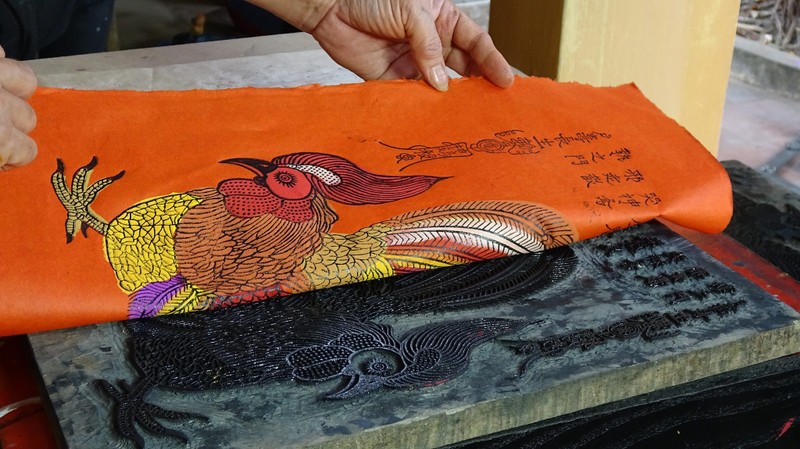Kim Hoang folk painting in Kim Hoang Village, Van Canh Commune, Hoai Duc District, Hanoi used to be a famous painting genre in northern delta region in the 18th Century. With bright colours, the paintings’ main topics were drawn from the daily life of people in the northern region: buffaloes, pigs, roosters, the rural landscape and daily activities.
However, the beautiful genre has largely disappeared over the past seven decades. According to elders in Van Canh Commune, many engravings of Kim Hoang paintings were lost in 1915 when the village suffered from heavy flooding. The unique genre of painting officially fell into oblivion in 1945, when the villagers faced crop losses and famine. Since then, Kim Hoang paintings can only be seen in old books. Searches for typical paintings of the genres in the Internet only bring about results of stamp-sized images.
Kim Hoang painting will disappear forever if it doesn’t catch the attention of arts collector Nguyen Thi Thu Hoa, who has a deep passion for folk paintings. Stunned by the charm of the genre as well as its unique production technique, Hoa came up with the idea of reviving the folk painting.
“It is a hard and arduous task,” Hoa said. From searching for reference documents, finding out the right ink colour, the right kind of paper as well as the most suitable background colour for the paper for producing the paintings, to searching for help from elders in the village who still have some understanding of the genre, they are all tough tasks.
 |
Arts collector Nguyen Thi Thu Hoa and reproductions of Kim Hoang folk paintings.
The project is being carried out in three stages. The first task is to recover 50 signature samples of Kim Hoang folk paintings, based on documents sourced from Imagerie populaire Vietnamienne (Popular Images in Vietnam), a book by Maurice M. Durand published in France in 2011. Accordingly, most Kim Hoang paintings featured the daily life of the people or illustrated popular fairy tales. They were drawn on orange-red coloured paper, using simple and thin strokes and painted in three major colours of white, light green and pink-purple.
In the second stage, woodcarving artists Nguyen Duc Hoa and Tran Nguyen Dan are invited to produce new samples of woodcut paintings for the genre, with the topics referenced from images engraved at Kim Hoang’s communal house.
In the third phase, Hoa plans to ask for permission from local authorities to start the construction of a place for producing and exhibiting Kim Hoang paintings.
As no engravings can be found in Kim Hoang, and few villagers still remember the production process, the project organised tours to Dong Ho in Bac Ninh Province for selected Kim Hoang villagers whose understanding of the genre is appreciated. Over the course of a couple of weeks, under the instruction of Dong Ho artisans, Kim Hoang villagers learnt about papers and inks of painting making as well as the production process. The villagers can now undertake several steps in the production process and perform in public so that people will understand more about the lost genre.
December 11, 2016 marked a memorial event when Kim Hoang folk paintings were officially introduced to Hanoi dwellers and foreigners for the first time at a Food Festival held by the Ministry of Foreign Affairs. It is a big step in the genre’s journey back to its golden age.
A 25m2 area was set up at Kim Hoang’s traditional house for the artisans and painters to produce paintings ahead of Tet (the lunar New Year festival). Forgotten for so long, bright-coloured Kim Hoang paintings will return to the arts market this spring as a strong signal proving that the vitality of the genre is still being nurtured and revived in a methodical way.
















